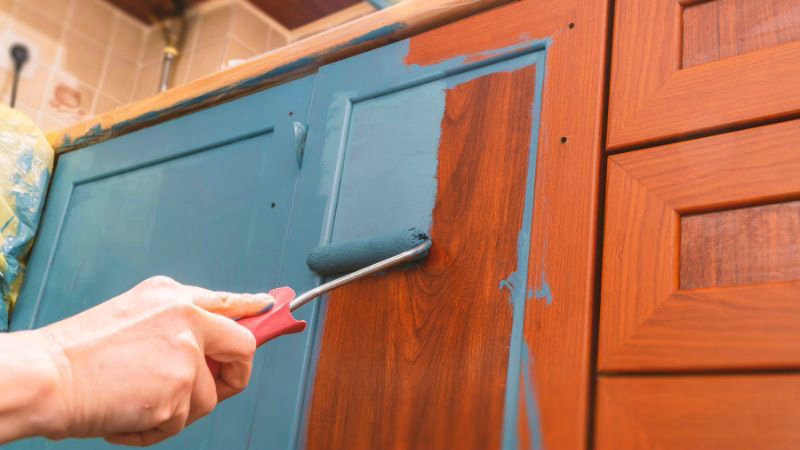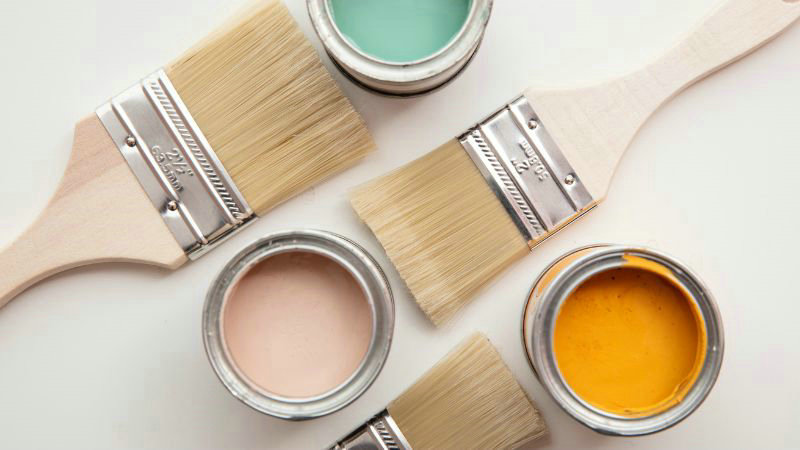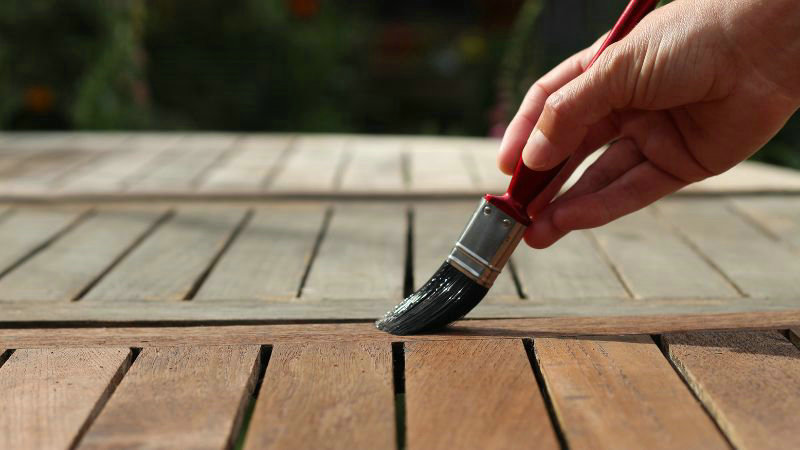
Wooden furniture adds warmth, character, and timeless appeal to any living space. However, choosing the right paint color to complement your wooden furniture piece can be a daunting task. The color you select can either enhance the natural beauty of the wood grain or clash with it, throwing off the entire aesthetic of the room.
In this article, we’ll explore tips and guidelines for selecting the best paint colors to harmonize with your wooden furniture, creating a cohesive and inviting interior design.
What are the Different Wood Types and Tones
Knowing the types and tones of wood helps you choose the right color for the piece of furniture. Each kind of wood has unique characteristics, which can influence the overall look and feel.
Different Types of Wood
Pine: Pine is soft, light-colored wood. It has a straight grain and occasional knots, giving it a rustic look. It’s often used in furniture and wood trims because it’s affordable and versatile.
Mahogany: This hardwood is known for its deep, rich brown color. Mahogany has a straight grain and is often used in high-end furniture. It’s durable and can be polished to a high shine.
Oak: Oak is strong and durable. It comes in two types: red oak and white oak. Red oak has warm tones, ranging from light brown to pinkish-red. White oak is cooler in tone, usually light beige to brown.
Ash: Ash wood has a straight grain and light color, usually white to light brown. It’s known for its strength and smooth finish, making it great for modern furniture designs.
Cherry: Cherry wood starts as a light pinkish shade and darkens over time to a rich reddish-brown. It’s prized for its smooth grain and is used in traditional furniture.
Walnut: Walnut is a dark hardwood, ranging from light brown to dark chocolate brown. It has a straight grain and is loved for its rich, warm color.
Maple: Maple is light-colored wood with a fine, straight grain. It’s very durable, making it ideal for heavy-use items like kitchen cabinets or butcher blocks.
Identifying Wood Undertones
Different woods have warm, cool, or neutral undertones. Identifying these undertones helps match your furniture with other colors in your home.
Warm Undertones: Woods like cherry, mahogany, and red oak have warm undertones. These woods appear more orange, red, or brown, adding coziness to a room.
Cool Undertones: Woods with cool undertones, such as ash, maple, and white oak, have a neutral or bluish hue. These are ideal for creating a calm and modern look.
Neutral Undertones: Some woods, like walnuts, have neutral undertones. They don’t lean too warm or cool, making them versatile for various color schemes.
What is the Classification of Colors?

Neutral colors like white and gray are a safe choice. They can match almost any wood color and create a balanced look. For a modern feel, you might like light grays or warm neutrals like greige.
Bold colors can make a big impact. Red, blue, and green can add a pop of color and energize the room. For a calmer look, choose lighter shades or pale versions of these colors.
Warm colors such as orange and yellow can brighten up your furniture and make it stand out. These colors work well with lighter wood tones, adding warmth and vibrancy to the space.
If you prefer a simpler look, black and dark browns can add elegance and sophistication. They go well with light-colored wood, creating a striking contrast.
Here are some popular paint color options for your wooden furniture:
- White: Timeless and versatile.
- Gray: Modern and neutral.
- Green: Fresh and natural.
- Blue: Calm and classic.
- Black: Bold and sophisticated.
- Yellow: Cheerful and warm.
- Red: Vibrant and dramatic.
How to Choose the Right Color for Your Wooden Furniture?
Choosing the right paint color to complement wooden furniture is an important decision that can greatly impact the overall look and feel of a room.
The first thing you should do is to evaluate the undertone of your wooden furniture. Here are the recommendations for you.
Light Woods (Oak, Maple, Pine, Ash, Birch)
Some good options are:
- Creams
- Beiges
- Light grays
- Soft greens
- Blues
Avoid stark whites or very gray colors because they make a look harsh against the warm tones.
Medium Woods (Cherry, Walnut, Red Oak)
Pair with:
- Greiges
- Taupes
- Warm grays
- Soft blues
Don’t use pure reds or oranges; they can clash with the red undertones in the wood.
Dark Woods (Mahogany, Espresso, Ebony)
You can consider:
- Cool grays
- Soft blues
- Greens
- Warmer whites
Carefully use stark whites, which can look too harsh against dark wood.
How to Achieve Color Harmony in Home Decoration

Creating Contrast and Harmony
When painting furniture, consider using contrasting colors to make a bold statement. For example, pair a white table with deep blue chairs. This contrast can make the furniture pop and become the focal point of the room.
Neutral paint colors like beige, gray, or white are perfect for creating a calm and cohesive atmosphere. If your walls and floors are neutral, a brightly painted chest or chair can add a splash of color without overwhelming the space.
Use the 60-30-10 rule – 60% of a dominant color, 30% of a secondary color, and 10% an accent color. This creates a balanced and harmonious look.
Using similar tones can create harmony. Mix different shades of the same color for a layered look. For instance, pair light gray cabinets with a slightly darker gray table. This method ensures everything looks coordinated without being too monotonous.
Accessorizing with Fabrics and Decor
After painting your furniture, adding the right accessories can further enhance your decor. Use rugs, pillows, and throws that complement your furniture colors. For instance, if you have a blue-painted dresser, a rug with blue accents can tie the room together.
Decorating with items that share similar color schemes can also create a unified look. Place vases, picture frames, or wall art in colors that match or contrast with your painted furniture.
Consider using fabrics in your decor, such as slipcovers or curtains, to bring everything together. If your painted furniture is a solid color, patterned fabrics in complementary shades can add visual interest.
By thoughtfully pairing accessories and fabrics, you can create a welcoming and coordinated space that beautifully highlights your painted furniture.
How to Maintain the Painted Furniture

Maintaining your wooden furniture can breathe new life into old pieces and protect their beauty for years to come. Proper care and thoughtful updates prevent damage and enhance the natural charm of the wood.
Caring for Painted Surfaces
Painted wooden surfaces require regular care to remain vibrant. Dust your furniture frequently with a soft cloth to remove any dirt and debris. Avoid harsh chemicals or abrasive cleaners as they can damage the paint.
If you notice any chips or scratches, touch them up using matching paint. Lightly sand the affected area, clean it, and apply paint with a small brush.
For more protection, consider using a clear varnish over the paint. This adds a layer of defense against scratches and wear. Ensure the varnish is compatible with your paint to avoid any bubbling or peeling.
Frequently Asked Questions
How do I choose a wall color to complement my wooden furniture?
Match the tone of your wood furniture with your walls for a cohesive look. Use similar shades to create a calm setting. For contrast, lighter walls with dark wood furniture or vice versa can be striking and stylish.
What are the best color combinations when painting wood furniture?
White and blue is a classic combination, offering a fresh and timeless look. Gray paired with yellow or teal can be modern and trendy. Black and white combinations are also very chic and versatile.
What colors match perfectly with pine furniture?
Light and natural colors like beige, cream, and soft pastels work well with pine. These shades enhance the warm, rustic qualities of the wood. For a bolder choice, consider teal or navy.
How do I select the right paint color for mahogany furniture?
Opt for colors that enhance mahogany’s rich, reddish-brown tones. Warm neutrals like beige, gold, or even rich olives can complement the wood. Navy and deep greens can also create an elegant contrast.
Which wood furniture tones are most versatile for decorating?
Lighter tones like oak and maple offer great versatility. They blend well with various color schemes and styles. Darker woods like walnut and cherry are also adaptable but create a more formal and rich atmosphere.






